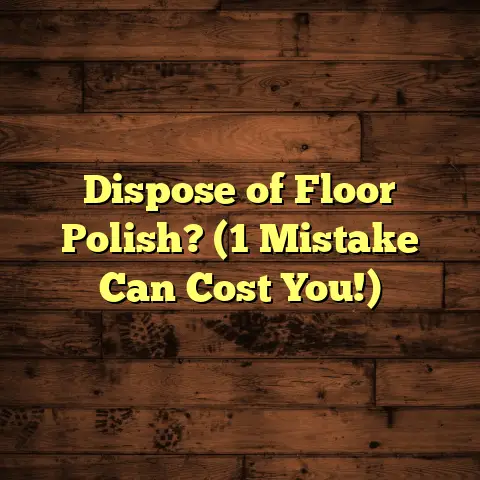Can Epoxy Floors Be Repaired? (8 Repair Don’ts!)
When it comes to flooring, how do we define taste?
Is it the sleek, modern look of polished concrete?
Or the warm, inviting feel of hardwood?
For many, the answer is epoxy floors.
Their glossy finish and incredible durability have made them a go-to choice for homes, garages, and even commercial spaces.
But let’s be real.
Choosing a floor is like picking the perfect outfit.
It’s a reflection of your personal style and needs.
And just like that favorite jacket, sometimes things go wrong.
That’s where the question of repair comes in.
Can epoxy floors be repaired?
Absolutely! But, there are some serious “don’ts” you need to know.
Trust me, I’ve seen it all in my years as a flooring contractor.
Let’s dive in and save you from some potential flooring disasters!
Understanding Epoxy Floors
Okay, so what exactly is epoxy flooring?
Think of it as a super-tough, two-part system.
You’ve got the epoxy resin and a hardener.
When mixed, they create a chemical reaction that results in a rigid, plastic-like surface.
Pretty cool, right?
I’ve installed epoxy floors in everything from bustling restaurant kitchens to quiet residential basements.
It’s incredibly versatile.
Benefits of Epoxy Floors:
- Durability: Seriously tough stuff. Resists impacts, scratches, and chemicals.
- Stain Resistance: Spilled oil in the garage? No sweat! Epoxy cleans up easily.
- Aesthetic Versatility: You can customize it with colors, flakes, metallic pigments – the works!
Despite all this awesomeness, epoxy floors aren’t invincible.
They can face some challenges over time.
And that’s where the question of repair comes into play.
Common Issues Faced by Epoxy Floors
Let’s talk about the ugly stuff.
What can actually go wrong with your beautiful epoxy floor?
Here are some common culprits I’ve encountered:
- Cracking: Hairline cracks to larger fissures, usually from stress or movement in the underlying concrete.
- Peeling or Delamination: The epoxy layer separates from the concrete.
This is often due to poor surface prep. - Yellowing or Discoloration: Especially with cheaper epoxies, UV exposure can cause yellowing.
- Bubbles and Blisters: Air trapped during application rises to the surface.
- Wear and Tear from Heavy Traffic: Even tough epoxy can wear down in high-traffic areas.
What causes these issues?
Often, it boils down to a few key factors:
- Improper Installation: This is HUGE. Skimping on prep work is a recipe for disaster.
- Environmental Factors: Temperature and humidity can wreak havoc during the curing process.
- Poor Quality Products: You get what you pay for.
Cheap epoxy often leads to problems down the road.
I’ve seen floors peel up just months after installation because of shoddy prep work.
Trust me, it’s not a pretty sight (or a happy client).
The Repair Process for Epoxy Floors
So, your epoxy floor has seen better days.
What do you do?
First, assess the damage.
Is it a small crack or a major peeling situation?
Sometimes, a simple patch will do the trick.
Other times, you might need to consider resurfacing or even a complete replacement.
When to Repair vs. Replace:
- Repair: Minor cracks, small areas of peeling, discoloration.
- Replace: Extensive cracking, widespread delamination, significant structural damage.
Types of Repairs:
- Patching: Filling in cracks or small damaged areas with epoxy.
- Resurfacing: Applying a new layer of epoxy over the existing floor.
- Refinishing: Sanding and applying a new topcoat to restore the shine.
The specific approach depends on the extent of the damage and the type of epoxy you have.
But regardless of the method, there are some critical “don’ts” you need to keep in mind.
And that’s what we’re going to dive into next.
The 8 Repair Don’ts
Alright, buckle up.
This is where I share the hard-earned wisdom I’ve gained from years of fixing (and sometimes re-fixing) epoxy floors.
These are the “don’ts” that can make or break your repair job.
1. Don’t Ignore Surface Preparation
I can’t stress this enough.
Surface prep is the foundation of any successful epoxy repair.
Think of it like painting a wall.
You wouldn’t just slap paint on a dirty, greasy surface, would you?
The same principle applies to epoxy.
Why it matters:
- Adhesion: Epoxy needs a clean, porous surface to bond properly.
- Contamination: Dirt, oil, and other contaminants can prevent the epoxy from adhering.
What to do instead:
- Clean Thoroughly: Use a degreaser to remove any oil or grease.
- Grind or Etch: This creates a rough surface for the epoxy to grip.
I recommend using a concrete grinder with diamond pads. - Vacuum: Remove all dust and debris before applying the epoxy.
I once had to redo an entire garage floor because the homeowner skipped the grinding step.
The epoxy peeled up within weeks.
Don’t make the same mistake!
2. Don’t Use Incorrect Products
Epoxy isn’t just epoxy.
There are different types, formulations, and brands.
Using the wrong product can lead to compatibility issues, poor adhesion, and a whole host of problems.
Why it matters:
- Chemical Compatibility: Different epoxies may react differently.
- Performance: Some epoxies are designed for specific applications (e.g., high-traffic areas, chemical resistance).
What to do instead:
- Identify the Existing Epoxy: If possible, determine the type and brand of epoxy already on the floor.
- Match the Product: Use the same type of epoxy for the repair.
If you can’t find the exact brand, consult with a flooring professional. - Read the Labels: Pay attention to the manufacturer’s recommendations for mixing, application, and curing.
I remember a client who tried to patch a commercial-grade epoxy floor with a cheap, DIY kit from a big-box store.
The patch cracked and crumbled within days.
It was a complete waste of time and money.
3. Don’t Skip the Primer
Primer is like the glue that holds everything together.
It creates a strong bond between the existing floor and the new epoxy.
Skipping the primer is like trying to build a house without a foundation.
Why it matters:
- Adhesion: Primer promotes better adhesion, especially on smooth or non-porous surfaces.
- Sealing: Primer seals the surface, preventing moisture from interfering with the epoxy.
What to do instead:
- Choose the Right Primer: Use a primer specifically designed for epoxy floors.
- Apply Evenly: Follow the manufacturer’s instructions for application.
- Allow to Dry: Let the primer dry completely before applying the epoxy.
I’ve seen floors peel up simply because the installer skipped the primer.
It’s a small step that makes a HUGE difference.
4. Don’t Overlook Temperature and Humidity Conditions
Epoxy is a finicky beast.
Temperature and humidity can significantly affect its curing time and adhesion.
Ignoring these factors can lead to a failed repair.
Why it matters:
- Curing Time: Temperature affects how quickly the epoxy cures.
- Adhesion: High humidity can interfere with the bonding process.
What to do instead:
- Check the Weather: Avoid applying epoxy on extremely hot, cold, or humid days.
- Maintain Consistent Temperature: Keep the temperature within the manufacturer’s recommended range during application and curing.
- Control Humidity: Use a dehumidifier if necessary to lower the humidity level.
I once had a project delayed for a week because of unexpected rain.
The high humidity would have ruined the epoxy.
It’s always better to be safe than sorry.
5. Don’t Rush the Curing Process
Patience is a virtue, especially when it comes to epoxy.
Rushing the curing process can lead to soft spots, bubbles, and other defects.
Why it matters:
- Full Strength: Epoxy needs time to fully cure to achieve its maximum strength and durability.
- Appearance: Rushing the process can result in an uneven finish.
What to do instead:
- Follow the Manufacturer’s Instructions: Pay close attention to the recommended curing time.
- Protect the Surface: Keep traffic off the floor during the curing process.
- Resist the Urge to Touch: Don’t poke or prod the epoxy while it’s curing.
I know it’s tempting to walk on your newly repaired floor, but resist the urge!
Give it the time it needs to cure properly.
6. Don’t Neglect Safety Precautions
Epoxy contains chemicals that can be harmful if not handled properly.
Protecting yourself is crucial.
Why it matters:
- Skin Irritation: Epoxy can cause skin irritation and allergic reactions.
- Respiratory Issues: Fumes can be harmful to breathe.
What to do instead:
- Wear Protective Gear: Gloves, safety glasses, and a respirator are essential.
- Ventilate the Area: Open windows and doors to ensure proper ventilation.
- Read the Safety Data Sheet (SDS): Understand the potential hazards and how to handle the product safely.
I always wear a respirator when working with epoxy.
It’s a small price to pay for protecting my lungs.
7. Don’t Attempt DIY Repairs Without Knowledge
I’m all for DIY projects, but epoxy repair is not always a walk in the park.
If you’re not comfortable with the process or don’t have the necessary knowledge, it’s best to call a professional.
Why it matters:
- Costly Mistakes: A poorly executed repair can actually make the problem worse.
- Time and Effort: You could end up spending more time and money trying to fix your mistakes.
What to do instead:
- Assess Your Skills: Be honest about your abilities.
- Research Thoroughly: Watch videos, read articles, and talk to professionals.
- Consider Hiring a Pro: If you’re unsure, it’s always best to leave it to the experts.
I’ve seen countless DIY epoxy disasters.
Sometimes, it’s cheaper to hire a professional from the start than to fix someone else’s mistakes.
8. Don’t Forget to Test Small Areas First
Before you commit to a full-scale repair, always test a small, inconspicuous area first.
This will allow you to gauge compatibility and ensure that the repair looks the way you want it to.
Why it matters:
- Color Matching: Epoxy colors can vary slightly.
- Adhesion: Testing ensures that the epoxy will adhere properly to the existing floor.
What to do instead:
- Choose an Inconspicuous Area: A corner or closet is a good choice.
- Apply the Epoxy: Follow the manufacturer’s instructions.
- Observe the Results: Check for color matching, adhesion, and overall appearance.
I always test my repairs before committing to the entire floor.
It’s a simple step that can save you a lot of headaches.
Conclusion
So, can epoxy floors be repaired?
Yes, absolutely!
But, as we’ve discussed, it’s crucial to approach the process with caution and knowledge.
Avoiding these eight “don’ts” will significantly increase your chances of a successful and long-lasting repair.
Remember, proper surface preparation, using the right products, and following safety precautions are key.
And if you’re ever in doubt, don’t hesitate to call a professional.
A little bit of knowledge and caution can go a long way in keeping your epoxy floor looking its best for years to come.
Now, go forth and conquer those epoxy repairs!





